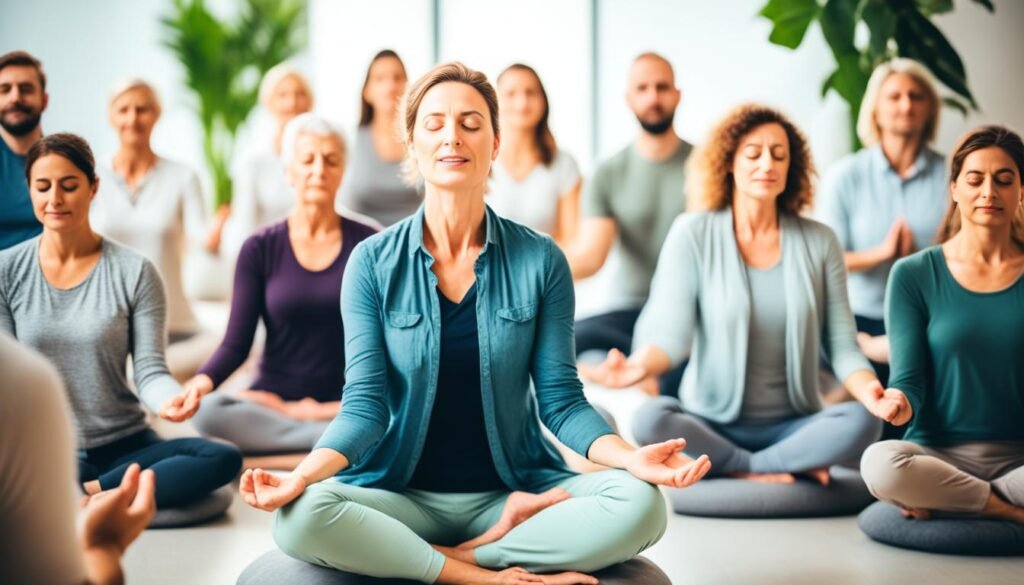How to lead a Meditation A Guide to Inner Peace

How to lead a Meditation, meditation has been around for centuries, offering a way to find deep inner peace and well-being. Guided meditation is a great choice for beginners. It helps you quiet your mind, focus on now, and relax deeply with the help of an expert.
Research shows that just 12 minutes of meditation, done 5 days a week, can boost your focus. Mindfulness exercises make you think more intentionally, not just on autopilot. Guided meditation uses your brain’s ability to change and grow, helping you make better choices.
Guided meditation can help you reduce stress, know yourself better, or just find peace. There are many types, like mindfulness and loving-kindness meditation, for different needs. Adding it to your daily life starts a journey of personal growth and discovery.
Key Takeaways
- How to lead a Meditation Guided meditation is a powerful tool for achieving inner peace and well-being.
- Consistent meditation practice, even for just 12 minutes a day, can enhance attention span and promote intentional decision-making.
- Mindfulness exercises activate the intentional brain, countering habitual behaviors driven by neural networks.
- Guided meditation techniques cater to various goals, such as stress reduction, self-awareness, and cultivating compassion.
- Incorporating guided meditation into your daily routine and embracing consistency are key to unlocking its transformative benefits.
Understanding the Power of Meditation
Meditation is an ancient practice that many cultures have embraced for centuries. It helps people find mental clarity, inner peace, and spiritual growth. Through it, people can connect deeply with themselves and the world.
Studies show meditation has many benefits. It can reduce stress, improve focus, and boost emotional and physical health. Regular practice leads to a balanced and clear mind, enhancing overall well-being.
Meditation changes the brain in amazing ways. Long-term practice can increase gray matter in areas linked to attention and self-awareness. This means people can improve their mental strength and clarity over time.
Anyone can learn to meditate, no matter their background. It’s simple and accessible. Even a few minutes a day can lead to inner peace and self-discovery. Guided meditation for beginners is a great way to start.
“Meditation is a way of learning how to let go. It is a way of learning how to be present in the moment, without judgment or attachment.” – Jack Kornfield
Meditation isn’t about reaching a goal. It’s about being present and aware. It’s a journey that can lead to personal growth and transformation. As you meditate more, you’ll understand yourself and the world better, leading to more compassion and peace.
| Meditation Practice | Benefits |
|---|---|
| Regular, consistent practice (10-20 minutes daily) | Reduced stress levels, improved focus and concentration, enhanced emotional well-being |
| Long-term practice (several years) | Structural changes in the brain, increased gray matter density, improved cognitive function |
| Incorporation into healthcare treatment plans | Potential for improved physical health outcomes, such as lower blood pressure and enhanced immune function |
Meditation changes people from the inside out. It helps us connect deeply with ourselves and the now. It’s a path to peace, clarity, and fulfillment. Whether you want to reduce stress, grow personally, or find spiritual awakening, meditation can help.
Types of Guided Meditation
Guided meditation comes in many forms, each with its own benefits for those seeking peace and growth. By trying different meditation types, you can find what suits you best.
Relaxation and Stress Reduction Meditation
One top type of guided meditation focuses on relaxation and stress relief. These meditations use breath awareness, muscle relaxation, and calming visuals. They help you relax and let go of tension.
Guided visualizations can take you to peaceful places like a quiet beach or a calm forest. This lets your mind and body fully relax.
Inner Strength and Resilience Meditation
Guided meditations for inner strength and resilience are powerful. They often use loving-kindness meditation. Here, you send kind thoughts to yourself and others.
This builds self-compassion and connection. It helps you handle life’s ups and downs with more ease.
Mindfulness Meditation
Mindfulness meditation focuses on being aware of the now without judgment. In these sessions, you watch your thoughts, feelings, and body without getting caught up in them. This practice helps you understand yourself better.
It can make you clearer, more focused, and emotionally balanced.
| Meditation App | Key Features |
|---|---|
| Muse | Over 300 guided meditations, monthly challenges, meditation streaks, progressive goals |
| Simple Habit | Five-minute meditations for users with time constraints |
| Amazon Alexa | Access to Muse guided meditation collection and courses, 14 free guided meditations included |
There are many more meditation styles to try, like transcendental meditation and sound bath meditation. These use mantras and vibrations to help you relax. Trying different styles can help you find what works best for you on your path to peace and well-being.
Benefits of Guided Meditation
Guided meditation is great for both the mind and body. It helps reduce stress, improve sleep, and boost well-being. With an experienced instructor’s guidance, even beginners can start to see its benefits.
Accessibility for Beginners
Guided meditation is easy to start with. It can be hard for beginners to quiet their minds at first. But, a skilled guide makes it simple to learn and enjoy meditation right away.
These meditations give clear, step-by-step instructions. This is great for those who have trouble focusing or get easily distracted.
Deeper Relaxation with Expert Guidance
Guided meditations can take experienced meditators deeper into relaxation and insight. Experts help them explore meditation’s subtleties. This leads to letting go of tension and being fully in the moment.
Studies show that guided meditation is great for reducing stress. In one study, those who learned mindfulness had a smaller stress response after eight weeks.
Improved Focus and Presence
Guided meditation also helps with focus and being present. By focusing on the breath or a point, you train your mind to stay centered. This makes it easier to ignore distractions.
This better focus helps in many areas of life, like work and relationships. In fact, a study found that listening to a meditation tape helped people do tasks better and faster.
| Benefit | Supporting Research |
|---|---|
| Stress Reduction | 84% of people in the United States began meditating to reduce stress. |
| Improved Sleep Quality | Participants guided through mindfulness-based therapy experienced a reduction in total waking time and insomnia severity. |
| Increased Well-being | Participants who used a mindfulness meditation app enjoyed improvements in well-being, distress, job strain, and perceptions of workplace social support. |
Guided meditation is a powerful tool for reducing stress, improving sleep, and increasing well-being. It helps bring peace, focus, and resilience into our lives.
How to Lead a Meditation
Leading a meditation is a rewarding experience. It lets you guide others on a journey of inner peace and self-discovery. By setting the right environment, guiding participants, and using effective meditation scripts, you can create a transformative experience.
Setting the Right Environment
The first step in leading a successful meditation is to create a peaceful and comfortable space. Choose a quiet location free from distractions. Add elements like cushions, blankets, candles, or soft lighting to promote relaxation. A serene environment helps participants feel at ease and focus on their meditation practice.
Guiding Participants through the Process
As a meditation leader, your role is to provide clear instructions. Use a calm and soothing tone throughout the session. Encourage participants to find a comfortable position for relaxation and focus. Demonstrate proper posture and breathing techniques. Offer gentle reminders to bring awareness back to the present moment when minds wander.
According to a recent survey, 11 out of 12 meditation experts stress the importance of mindfulness during guided meditation. They highlight the benefits of meditating while leading to enhance the quality of the experience.
“Leading a meditation is not just about the words you say, but the presence you bring to the practice. By embodying mindfulness and compassion, you create a space for others to explore their own inner wisdom.” – Thich Nhat Hanh, renowned Buddhist monk and mindfulness teacher
Using Effective Meditation Scripts
Meditation scripts act as a roadmap for your sessions. They provide structure and direction for you and your participants. Choose scripts that match your technique, whether it’s mindfulness, loving-kindness, or guided visualization. Effective scripts should be well-structured, easy to follow, and tailored to the participants’ level of experience.
When selecting or creating meditation scripts, consider these tips:
- Use simple, clear language that is easy to understand
- Include pauses and moments of silence to allow for deeper reflection
- Incorporate sensory descriptions to engage the imagination
- Offer variations and modifications to accommodate different needs and preferences
| Meditation Technique | Key Elements | Benefits |
|---|---|---|
| Mindfulness Meditation | Focusing on the present moment, observing thoughts and sensations without judgment | Reduces stress, improves emotional regulation, enhances self-awareness |
| Loving-Kindness Meditation | Cultivating feelings of love, compassion, and goodwill towards oneself and others | Increases positive emotions, fosters empathy and connection, promotes self-acceptance |
| Guided Visualization | Using mental imagery to create a peaceful, healing, or empowering experience | Reduces anxiety, promotes relaxation, supports goal achievement and personal growth |
By mastering meditation instruction and mindfulness facilitation, you can create a transformative experience. This helps participants find inner peace, resilience, and a deeper connection to themselves and others.
Preparing for a Guided Meditation Session
Before starting a guided meditation, it’s key to prepare well. Create a calm space that helps everyone relax and focus. Pick a quiet spot where people can sit or lie down easily. Make sure the room is at a good temperature and well-ventilated.
Setting intentions for the meditation is also vital. Think about what you want to achieve, like reducing stress or finding peace. Having a clear goal will help guide your words and actions during the session.
“The most important thing is to be authentic, to be yourself, and to allow your own style of teaching to come through.” – Jon Kabat-Zinn
Think about what your participants might need as you get ready. Have things like cushions, blankets, or chairs ready. You might also want to play soft music to make the space more relaxing.
| Preparation Step | Description |
|---|---|
| Choose a peaceful environment | Select a quiet, comfortable space free from distractions |
| Set intentions | Reflect on the purpose and goals of the meditation session |
| Gather necessary props | Provide cushions, blankets, chairs, or other items for comfort |
| Create a soothing ambiance | Play calming background music or nature sounds |
Before starting, take a moment to calm yourself and get centered. Go over your meditation plan or script, and adjust it if needed. The key is to be true to yourself and let your unique teaching style shine.
By preparing well, creating a calm space, and setting clear goals, you’ll be ready to lead a powerful and meaningful meditation session.
Techniques for Teaching Meditation
Teaching meditation is an art that needs a deep understanding and the skill to share its ideas clearly. As a leader in meditation, learning different meditation teaching techniques is key. These skills help guide students towards peace and self-discovery.
Demonstrating Proper Posture and Breathing
Showing the right posture and breathing is vital in guiding meditation. By sitting correctly, you encourage students to sit comfortably and mindfully. Teaching them about mindful breathing helps them start their practice on a strong note.
Studies show that even 3-year-olds can learn mindfulness. This shows how important it is to adjust your teaching for different ages. Teaching meditation to kids, teens, and adults all require different skills. But, the basics of posture and breathing stay the same.
Providing Clear and Concise Instructions
Clear communication is crucial in meditation teaching. Use simple language and break down complex ideas into steps. Avoid using hard words that might confuse beginners.
It’s key to balance guidance and silence in teaching meditation. Beginners might feel lost if you talk too much. Experienced teachers might be too quiet, leaving new students confused. Try to mix up the silence, from two breaths to eight or more, to help everyone reflect.
Maintaining a Calm and Soothing Tone
Your voice greatly affects the mood of a meditation session. Keep your tone calm and speak at a pace that lets students follow along. Your voice should be peaceful and reassuring, making students feel secure as they explore their inner selves.
As a meditation leader, how you handle emotions in sessions shows your own practice. A strong personal practice and deep meditation knowledge help you guide others with care and insight. Whether you got your blessing from a teacher or went through a training program, your dedication will show in your teaching. This inspires your students to see the power of meditation.
Overcoming Common Challenges in Meditation Leadership
Leading others in meditation can be very rewarding. But, it also has its challenges. By tackling these issues, you can make your sessions better for everyone.
Dealing with Distractions and Restlessness
Distractions are a big issue in meditation. People might feel restless or uncomfortable. As a leader, it’s key to help them focus again without criticism.
Tell your participants to be kind to their thoughts and feelings. They’re normal parts of the practice, not problems. The aim is to watch them with care and understanding.
The mind is a wild thing, like a monkey or a drunken monkey, or a monkey stung by a scorpion, or a hungry ghost. Jumping about and racing around, it is very difficult to control. But it is not impossible. – Ajahn Chah
Encouraging Consistent Practice
Getting into a regular meditation habit is key to seeing its benefits. As a leader, you can help by stressing the need for regular practice. Offer tips and resources to keep your participants going.
Share advice on setting up a meditation spot at home and setting achievable goals. Suggest starting with short sessions and slowly increase time as they get more comfortable.
| Common Meditation Challenges | Strategies for Overcoming |
|---|---|
| Falling asleep | Sit upright, practice at a time when you’re alert |
| External distractions (e.g., noise) | Find a quiet space, use earplugs or white noise |
| Physical discomfort or restlessness | Adjust posture, use props for support, practice mindful movement |
| Emotional difficulties (e.g., anger, sadness) | Observe emotions without judgment, practice self-compassion |
| Mental busyness or overthinking | Focus on the breath, use a mantra, practice labeling thoughts |
With patience and the right strategies, you can help your participants overcome common meditation hurdles. Remember, meditation is a journey. As a leader, your job is to guide, support, and inspire them.
Incorporating Mindfulness Exercises into Meditation
Mindfulness techniques are great for making meditation better. They add depth and make it more effective. By using exercises like the body scan, mindful movement, and focused awareness, leaders help people feel more present and relaxed.
The body scan is a key mindfulness technique. It involves paying attention to different parts of the body, from toes to the top of the head. This helps people notice physical feelings without judging them. It connects them more with their body and the now. Studies show that doing this meditation often can lower stress and anxiety. It makes people feel better overall.
Mindful movement, like gentle yoga or tai chi, is also good for meditation. It involves moving slowly and breathing deeply. This helps people feel more connected to their body and mind. It’s great for those who can’t sit still during regular meditation.
“Mindfulness is the aware, balanced acceptance of the present experience. It isn’t more complicated than that. It is opening to or receiving the present moment, pleasant or unpleasant, just as it is, without either clinging to it or rejecting it.” – Sylvia Boorstein
Other exercises you can add to meditation include:
- Mindful eating: Focus on the taste, texture, and smell of food
- Mindful walking: Notice how your feet touch the ground and your body moves
- Mindful listening: Pay full attention to the sounds around you without thinking about them
| Mindfulness Exercise | Benefits |
|---|---|
| Body Scan | Reduces stress and anxiety, improves body awareness |
| Mindful Movement | Enhances mind-body connection, promotes physical relaxation |
| Mindful Eating | Increases appreciation for food, reduces mindless eating |
| Mindful Walking | Improves focus and concentration, reduces rumination |
Adding these exercises to meditation makes it more complete and fun. It helps people feel more present, kind, and peaceful. As they practice mindfulness regularly, they might see positive changes in their life. This can improve their relationships, work, and overall happiness.
Creating a Supportive Meditation Community
Building a strong, inclusive meditation community is key for a sense of belonging and growth. It helps people feel connected and inspired in their practice. Meditation leaders create a supportive space for this to happen.
Fostering a Safe and Inclusive Environment
To make your group welcoming, set clear rules for talking and behaving. Make sure everyone feels included by offering diverse and accessible meditation options. Think about these points:
- Choose a calm place for your sessions.
- Keep meditations gentle and easy to follow.
- Use music, singing bowls, or essential oils to make it better.
- Have rules to keep things calm and focused.
Encouraging Sharing and Discussion
Encourage people to share their thoughts and feelings, in groups or one-on-one. This sharing helps everyone learn from each other and support one another. Here’s how to make it work:
- Make the post-meditation talks supportive.
- Guide people on how to share without judgment.
- Have tissues ready and make sure everyone feels grounded before leaving.
- Encourage chatting after sessions to keep the connection strong.
“Group meditation can enhance commitment to the practice and foster a sense of belonging.”
Organizing Group Meditation Sessions
Have regular group meditation times, in person or online, to help everyone stay on track. Think about these things when planning:
| Factor | Recommendation |
|---|---|
| Group Size | Start small, 2-3 people, or grow to 6-8 for online sessions. |
| Meeting Frequency | Meet weekly or monthly, based on what the group likes. |
| Session Duration | One hour, with 30 minutes of quiet meditation and 30 minutes of talk. |
| Facilitator Role | It can be one person, rotate, or share among a few. |
| Session Themes | Pick uplifting themes like ‘Love’, ‘Peace’, or ‘Ocean’ for each session. |
| Fees | Charge a little to cover costs, or use an honesty box. |
Adding things like book clubs, retreats, or workshops can deepen people’s meditation practice. Keeping track of what you do, who comes, and your costs helps you see how your group is doing. This makes your meditation community strong and lasting.
Continuing Education for Meditation Leaders
Your journey as a meditation leader is ongoing. It’s key to keep learning to deepen your practice and stay updated with new research and techniques. By focusing on professional development, you can give your students a better experience.
Enrolling in advanced meditation training programs is a great step. The American Institute of Health Care Professionals offers a 75 CEU program called Foundations of Meditation Certification. It’s self-paced and online, letting you learn at your own speed. You’ll join a community of over 60,000 students from around the world.
This certification program takes a minimum of 6 weeks to complete. It includes pre-recorded lectures, ebooks, and 1:1 support. You’ll also get mentorship and a journal for writing. Plus, you can get help via chat, email, or phone any day of the week.
Workshops and retreats led by experts can also enhance your skills. These events let you deepen your practice and learn new traditions and styles. They’re a chance to grow personally and find new ways to teach your students.
Going to conferences and seminars keeps you up-to-date with meditation research. These events let you meet other professionals, share ideas, and learn from leading experts. It’s a great way to network and improve your teaching.
“The more we practice meditation, the more we come to understand its profound impact on our lives and the lives of those we teach. Continuing education allows us to deepen this understanding and share it with others in increasingly meaningful ways.” – Eileen Rose Miles, Meditation Guide on Insight Timer
Improving your teaching skills is also crucial. Learning how to listen, give feedback, and manage groups makes your classes better. Look for courses or workshops on these topics to boost your teaching skills.
Getting certifications in meditation teaching shows your dedication to the field. The Inward Journey Meditation Teacher Training is a 12-week online program. It covers meditation’s history, techniques, and how to teach in your own style.
| Program | Duration | Format | Key Features |
|---|---|---|---|
| Foundations of Meditation Certification | Minimum 6 weeks | Self-paced, remote | 75 CEUs, pre-recorded lectures, ebooks, 1:1 support, mentorship |
| Inward Journey Meditation Teacher Training | 12 weeks | Virtual | Weekly group sessions, peer group sessions, 1:1 sessions, private community |
By taking part in continuing education, you’ll become a more skilled and confident meditation leader. You’ll be ready to guide others on their path to peace and well-being.
Conclusion
How to lead a Meditation, Leading meditation is a journey that changes lives. It helps people find peace, clarity, and personal growth. Leaders guide others through techniques like Vipassana and Secular Mindfulness. This helps reduce stress and improve well-being.
As meditation grows worldwide, skilled leaders are key. They create supportive groups and use mindfulness exercises. This makes a safe place for people to explore themselves.
Leaders use over 12,000 royalty-free music tracks and sound effects. This makes meditations engaging and deep. They help people relax and explore their inner selves.
Leaders share their knowledge through guided meditations and workshops. They help people see meditation’s benefits, like less thinking and more kindness. As leaders grow, they keep learning and caring for others. This makes the world more mindful and kind.
















